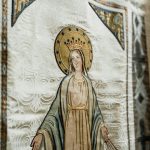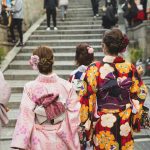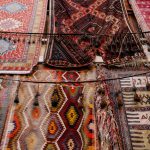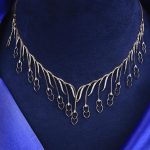Discover how historical garments were transformed by the unique properties of different fabrics. From the ancient drapes that revealed the secrets of civilizations to the elegant silk and brocade of the Renaissance, each era brought its own distinctive style.
Uncover the influence of fabric on iconic fashion silhouettes, from the restrictive Victorian era to the technological innovations of modern times. Immerse yourself in the rich tapestry of history and witness how fabric shaped the very essence of fashion.
Table of Contents
Ancient Fabrics: Unveiling the Secrets of Drapery
To understand the secrets of drapery in ancient fabrics, you must explore the intricate ways in which these textiles were shaped and manipulated.
Ancient drapery techniques played a significant role in creating garments that were both functional and aesthetically pleasing. Historically, people relied on various methods to achieve the desired drape and structure in their fabrics.
One of the key techniques used in ancient drapery was pleating. By folding the fabric in a specific pattern, skilled artisans created intricate pleats that added texture and movement to the garments. These pleats were carefully secured using stitching or other fastening methods to ensure they remained in place.
Another technique commonly employed in ancient drapery was draping. This involved skillfully arranging the fabric on a dress form or directly on the body to achieve the desired shape and fit. By manipulating the fabric and using pins or other temporary fasteners, artisans were able to create stunning drapes that accentuated the natural curves of the wearer.
Preserving historical textiles is crucial for understanding ancient drapery techniques. Textile preservation involves careful documentation, conservation, and restoration of ancient fabrics to maintain their integrity and ensure their longevity. By studying preserved garments, researchers can unravel the secrets of ancient drapery techniques, providing valuable insights into the artistry and craftsmanship of the past.
Medieval Weaves: Unraveling the Tapestry of Fashion
Now it’s time to explore the fascinating world of medieval weaves and how they shaped the tapestry of fashion.
Discover how fabric’s influence on fashion was intricately woven into the garments of the time, as weaving techniques played a crucial role in creating unique and intricate textiles.
Take a glimpse into the past and unravel the secrets behind historical garments and the textiles that defined them.
Fabric’s Influence on Fashion
Discover how fabric weaves in the medieval era shaped the fashion trends of the time. The textile innovations and sustainable fashion practices of the era greatly influenced the garments that were worn.
Here are three ways in which fabric weaves impacted medieval fashion:
-
Complex Weaving Techniques: Medieval weavers developed intricate weaving techniques, such as brocade and damask, which created beautiful patterns and textures. These fabrics were highly sought after and were used to create luxurious garments for the nobility.
-
Functional Fabrics: The weaves used in medieval fashion weren’t just decorative but also served practical purposes. Fabrics like wool and linen were durable and provided insulation, making them ideal for the harsh medieval climate.
-
Symbolism in Weaves: The patterns woven into fabrics often held symbolic meaning. For example, the Bayeux Tapestry depicted the events of the Norman Conquest, showcasing the power and authority of the ruling class.
The fabric weaves of the medieval era played a significant role in shaping fashion trends, showcasing the creativity, functionality, and symbolism that were valued during that time.
Weaving Techniques in Fashion
As you explore the fascinating world of medieval fashion, unravel the tapestry of fashion by delving into the intricate weaving techniques that shaped historical garments.
Weaving techniques in fashion played a crucial role in the design and construction of garments during this era. The impact of textiles on garment design can’t be overstated. Different weaving techniques, such as plain weave, twill weave, and satin weave, were used to create fabrics with varying textures, patterns, and drape.
These fabrics, in turn, influenced the overall silhouette and functionality of the garments. For example, tightly woven fabrics like twill were often used for outerwear to provide durability and protection against the elements. On the other hand, lightweight and loosely woven fabrics were used for undergarments to provide comfort and breathability.
The skillful use of weaving techniques allowed medieval fashion to be both functional and aesthetically pleasing.
Historical Garments and Textiles
Explore how historical garments from the medieval era were shaped by the intricate weaves of fabric. Textile production played a crucial role in creating the stunning fashion of the time. Here’s how:
-
Medieval Weaves: The weaving techniques of the medieval period were diverse and complex. From plain weaves to twills and brocades, each fabric had a unique texture and pattern, adding depth and richness to the garments.
-
Quality and Durability: The attention to detail in textile production ensured that historical garments weren’t only stylish but also durable. Fabrics were carefully chosen and woven to withstand the test of time, reflecting the craftsmanship of the era.
-
Symbolism and Status: Historical fashion was often used as a symbol of wealth and societal status. The use of luxurious textiles like silk and velvet, combined with intricate weaves and embellishments, showcased the wearer’s affluence and power.
Renaissance Elegance: The Artistry of Silk and Brocade
As you explore the opulence of Renaissance fabrics, you’ll discover their profound influence on the structure of garments.
Silk and brocade, with their intricate weaves and vibrant colors, were favored materials during this era of elegance.
These fabrics not only showcased the artistic techniques of the time but also added a touch of luxury and sophistication to Renaissance fashion.
Opulence of Renaissance Fabrics
Discover the opulence of Renaissance fabrics, where silk and brocade showcased the artistry of the era. The luxurious textiles of the Renaissance era were known for their opulence and grandeur, reflecting the wealth and status of the individuals who wore them. Here are three reasons why these fabrics were so highly regarded:
-
Intricate designs: Silk and brocade were meticulously woven, often featuring elaborate patterns and motifs. These intricate designs added an extra layer of sophistication and elegance to the garments.
-
Rich colors: Renaissance fabrics were dyed using vibrant and rich colors such as deep blues, purples, and golds. These bold hues further enhanced the luxurious feel of the textiles.
-
Sumptuous textures: Silk and brocade had a luxurious texture that was smooth to the touch. The fabrics had a slight sheen, giving them a regal and extravagant appearance.
The opulence of Renaissance fabrics, with their intricate designs, rich colors, and sumptuous textures, truly captured the elegance and grandeur of the era.
Influence on Garment Structure
How did the artistry of silk and brocade in Renaissance fabrics influence the structure of historical garments?
The intricate patterns and luxurious textures of silk and brocade played a significant role in the construction of garments during this era. Garment construction was greatly influenced by the unique qualities of these textiles, as they were often manipulated and shaped to create desired silhouettes.
Textile manipulation techniques, such as pleating, folding, and draping, were used to enhance the elegance and opulence of the garments. The stiffness of brocade allowed for the creation of structured bodices and voluminous skirts, while the softness and drape of silk lent itself to flowing sleeves and delicate detailing.
The artistry of silk and brocade not only added visual appeal but also shaped the overall structure and form of Renaissance clothing.
Artistic Techniques Showcased
The artistry of silk and brocade in Renaissance fabrics continues to be showcased through various artistic techniques that enhance the elegance and opulence of historical garments.
These techniques include:
-
Artistic Drapery: Renaissance garments were known for their exquisite drapery techniques, which created beautiful folds and pleats in the fabric. This added depth and dimension to the garments, giving them a sense of movement and grace.
-
Weaving Techniques: The intricate weaving techniques used in silk and brocade fabrics during the Renaissance added to their luxurious appearance. These techniques, such as brocading and damask weaving, created intricate patterns and designs that were highly sought after.
-
Embellishments: Renaissance fabrics were often embellished with embroidery, beading, and metallic threads. These embellishments added a touch of opulence and sophistication to the garments, making them even more visually stunning.
Baroque and Rococo Splendor: Exquisite Fabrics for Extravagant Styles
You can explore the extravagant styles of Baroque and Rococo splendor through the exquisite fabrics that shaped historical garments. The Baroque and Rococo periods were known for their opulent and lavish fashion, and the choice of fabric played a crucial role in achieving these extravagant styles. The use of exquisite fabric techniques and the fabric’s impact on opulence were key factors in creating the grandeur and luxury associated with these periods.
In Baroque and Rococo fashion, fabrics were chosen for their richness, texture, and ability to drape and flow. Silk, satin, and brocade were popular choices, often embellished with elaborate embroidery, lace, or metallic threads. These fabrics were not only visually stunning but also had a tactile quality that added to the overall luxurious feel of the garments.
To give you a better understanding of the fabrics used during this period, here is a table showcasing some of the exquisite fabric techniques and their impact on opulence:
| Exquisite Fabric Techniques | Fabric’s Impact on Opulence |
|---|---|
| Brocade | Intricate patterns and metallic threads create a rich and luxurious look. |
| Silk | Smooth and lustrous, silk adds a sense of elegance and sophistication. |
| Lace | Delicate and intricate, lace adds a romantic and feminine touch. |
| Embroidery | Elaborate designs and intricate stitching elevate the garment’s aesthetic. |
Industrial Revolution: From Cotton to Empire Waistlines
During the Industrial Revolution, cotton fabrics shaped the popular empire waistlines of historical garments. The cotton revolution had a significant impact on the fashion industry, revolutionizing the way garments were made and worn.
Here are three ways in which cotton fabric influenced empire waistlines:
-
Accessibility: The cotton revolution made cotton fabric more affordable and readily available to the masses. This accessibility allowed for the production of garments with empire waistlines on a larger scale, making the style accessible to a wider range of people.
-
Comfort: Cotton fabric’s lightweight and breathable nature made it the perfect choice for empire waistlines. The loose-fitting, high-waisted style of the empire silhouette required a fabric that could drape elegantly and provide comfort for the wearer, and cotton fit the bill perfectly.
-
Versatility: Cotton fabric’s versatility allowed for a wide range of designs and embellishments on empire waistlines. It could be easily dyed, printed, or embroidered, adding intricate details and patterns to the garments. This versatility made empire waistlines even more fashionable and visually appealing.
The cotton revolution had a profound impact on the fashion industry, shaping the popular empire waistlines of historical garments. Its accessibility, comfort, and versatility made cotton fabric the perfect choice for this iconic style.
Victorian Restriction: How Fabric Shaped Fashion’s Most Iconic Silhouette
Fabric played a crucial role in shaping the iconic silhouette of Victorian fashion. During the Victorian era, fabric manipulation techniques and the evolution of fashion went hand in hand. The restrictive nature of the era’s clothing was a reflection of societal norms and values, as well as the physical limitations imposed by the fabric itself.
One of the key features of Victorian fashion was the emphasis on a tiny waistline. To achieve this, corsets were tightly laced around the waist, shaping the body and creating an exaggerated hourglass figure. The corset, made primarily of strong and durable fabrics such as cotton or silk, provided the necessary support to maintain the desired silhouette.
The table below showcases some fabric manipulation techniques used in Victorian fashion:
| Technique | Description |
|---|---|
| Ruching | Gathering fabric to create decorative pleats or ruffles |
| Smocking | Embroidery technique used to create stretchable fabric panels |
| Bustles | Padded understructures to enhance the shape of the rear |
| Crinoline | Hoop skirt made of horsehair or steel for volume and shape |
| Puff sleeves | Gathering fabric at the shoulders for a voluminous effect |
As fashion evolved, so did the fabric choices and manipulation techniques. The Victorian era saw the introduction of new fabrics such as synthetic materials and the use of intricate lace and embroidery. These innovations allowed for more elaborate and detailed designs, further enhancing the overall silhouette.
Modern Innovations: Exploring Technological Advances in Fabrication
Numerous technological advances have revolutionized fabric production in recent years, transforming the fashion industry. These advancements have had a significant impact on garment construction, allowing designers to create innovative and unique pieces.
Here are three key technological advancements that have shaped the world of fabric production:
-
3D Printing: This cutting-edge technology has opened up a whole new realm of possibilities in garment construction. Designers can now create intricate and complex patterns and structures with ease. 3D printed fabrics can be lightweight, flexible, and customizable, offering endless design options.
-
Smart Fabrics: With the integration of technology, fabrics can now do more than just cover the body. Smart fabrics are embedded with sensors, microchips, and conductive materials, allowing them to interact with the wearer and the environment. These fabrics can monitor vital signs, adjust temperature, and even provide haptic feedback, enhancing the functionality and comfort of garments.
-
Sustainable Fabrics: Technological advancements have also led to the development of sustainable fabrics. From recycled materials to bio-based textiles, these fabrics are created with minimal environmental impact. They offer an alternative to traditional fabrics, reducing waste and promoting a more sustainable fashion industry.
These technological advancements in fabric production haven’t only transformed the way garments are constructed but have also opened up new possibilities for creativity and sustainability in the fashion industry.
Frequently Asked Questions
What Are Some Common Fabrics Used in Ancient Garments?
Common fabrics used in ancient garments were influenced by the ancient cultures and their preferences. Fabric quality was of utmost importance as it determined the durability and comfort of the garments.
How Did Medieval Weaves Contribute to the Overall Design of Clothing?
Medieval weaving techniques greatly influenced the overall design of clothing. The specific weave of the fabric determined the structure and shape of the garment, making it essential in creating different styles and silhouettes.
What Types of Silk and Brocade Were Popular During the Renaissance?
Silk brocades were popular during the Renaissance, adding opulence and texture to fashion. The rich fabrics were used to create elaborate designs and patterns, shaping garments that showcased wealth and status.
How Did the Use of Exquisite Fabrics Enhance Baroque and Rococo Styles?
Exquisite fabrics greatly impacted the structure of baroque and rococo styles. The choice of fabric influenced historical fashion trends by shaping the garments and enhancing their overall aesthetic appeal.
How Did the Industrial Revolution Impact the Availability and Affordability of Cotton in Fashion?
The industrial revolution had a profound impact on the availability and affordability of cotton in fashion. Its mass production techniques increased the availability of cotton, making it more accessible and affordable for everyday people.
- Can You Paint on Calico Fabric? A Guide for Artists and Crafters - June 19, 2025
- The History of Calico: What Did Fabric From the 1800s Look Like? - June 19, 2025
- Is Calico Fabric a Good Choice for Making Face Masks? - June 19, 2025






